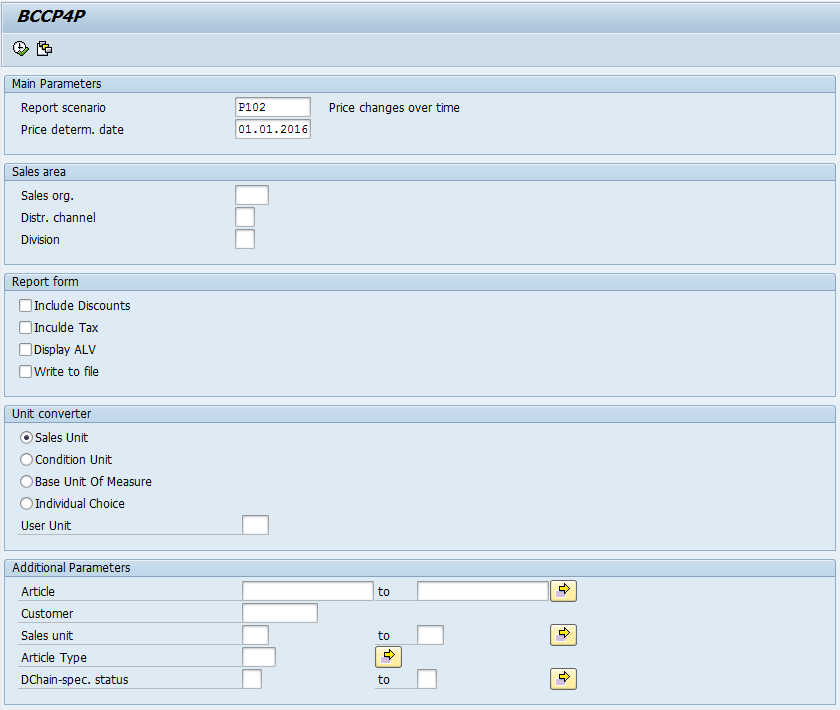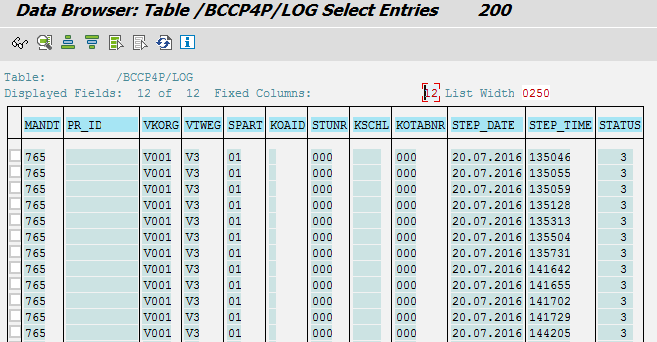All for One Pricing for Profit is a tool available in the All for One SAP Add-ons offering of unique products that enable you to increase the efficiency of SAP systems at low cost. Using the data existing in SAP ERP, it allows you to to gather and analyze at a single place the information regarding pricing conditions that make up the final price of the product. It considerably facilitates the planning and management of the company’s pricing strategies.
The results of the tool operation are presented in a legible and user-friendly ALV report with standard ALV-SAP functionalities, such as summation (including the subtotals), grouping, etc. The user can also use a definable file.
The product can be also integrated with third party systems, since in addition to presenting the results in a direct way it enables the transfer of data, e.g. via WebService.
Furthermore, the solution is easy to use and manage. Using a simple configuration, the user decides himself what data he wants to view and for what period. If customized solutions are used in the company, All for One Pricing for Profit can be adapted to the specific customer requirements through the mechanism of plug-ins. The tool is well-suited both for simple analyses of prices as well as for more complex schemes where the time-consuming data acquisition is too costly.
Indispensable in the active shaping of prices
The solution is designed for both small and medium-sized companies as well as large enterprises.
All for One Pricing for Profit is not limited by the amount of data processed. Thanks to the in-memory processing, data processing is not time-consuming, even for large volumes of data and complicated processing algorithms.
The product will be a helpful tool for any company that pursues an active pricing policy (price changes over time, discounts) and requires detailed and comprehensive analyses regarding price changes. The solution is also a good choice if the prices are determined in a non-standard way or you want to approach the scope of analyzed data (e.g. selected pricing conditions or products based on any field, e.g. custom solutions) in a dedicated way.
The plugin system allows for virtually every client algorithm to be mapped in All for One Pricing for Profit.
Key advantages
The main advantage of our product is a comprehensive approach to the pricing and price analysis. Detailed analyses can be obtained with just a few clicks. All for One Pricing for Profit allows the configuration of procedures to be freely tailored to the user so that the desired result is achieved if it cannot be obtained using standard SAP tools or time-consuming analyses must be made and third party tools, such as MS Excel or Calc, must be used in order to obtain a similar result.
The ability to analyze prices over time, also in the future, enables us to plan the sales of individual products, which will later on help increase the sales efficiency (e.g. by making adjustments to the initial pricing policy) and ultimately, the company’s revenue.
An insider’s view of All for One Pricing for Profit
The above description of the solution capabilities might suggest that it is a complicated product that the user will not be able to use without the knowledge of advanced configuration. Nothing could be further from the truth.
In addition to a high level of configurability and adaptability to the specific needs of users, the developers of All for One Pricing for Profit aimed also at the maximum simplification of both configuration forms and the everyday use tool itself. For the tool developers, who for many years were also users of the system, the intuitiveness of the solution and its transparency are as important as its capabilities. The use of Pricing for Profit consists of several steps (see the scheme below).
Selection screen – here the user enters the parameters to be used as a basis for price calculation. In addition to the sales area data and material data, the user can also select a calculation variant (including a discount and taxes), a unit in which prices are to be specified as well as the output data profile (ALV, FILE, FILE + ALV).

All for One Pricing for Profit selection screen
List of materials – this is an internal step, however the configuration possibilities offered by the product are worth mentioning here. In the basic installation, a standard template and procedure for downloading materials are provided. If for some reason a non-standard way of downloading materials is required, the mentioned plugins can be used.
In the case of materials, it is WORK-PLUGIN – marked successively with WORK_XXX. This is nothing else than a portion of the ABAP code written according to the customer’s individual needs so that the selection of the list of materials for the analysis meets the customer’s requirements. Thanks to this tool, the user does not have to analyze lists of materials via the screen selection each time anew. It provides the user with a predefined procedure that can also analyze additional custom fields, often containing the customer’s process logic. The plugin or plugins written in this way are properly assigned to specific targets by the user himself in the configuration.

A basic configuration screen
The versatility of the solution provides the end user with a whole array of capabilities and tools without imposing the only right and possible solutions.
Price calculation – at this stage, records of price conditions are processed, linked with the materials and verification as at the valuation date. Then, the final price and its components are determined based on the configuration in which the customer decided what price conditions were of interest to him and how they were to be processed.

A screen for configuration of pricing conditions
Just as in the case of lists of materials, also here the customer can influence the method of calculation and decide about calculation rules. For example, if the method of calculation of any price is non-standard, it is to be determined for the analysis purposes e.g. on the basis of other rules, this can be implemented as part of calculating plug-ins, the so-called CALC-PLUGIN.
Displaying a result – depending on the options selected to generate a result, the customer receives the result in the form of an ALV list and/or a file.

A result of the Pricing for Profit analysis in the form of ALV
A report in the form of ALV is prepared in accordance with the functionality of standard SAP-ALV reports. This means that in a standard way you can use the functionality of summation (including the subtotals), adjusting the appearance to suit your own needs or exporting to external formats.
A report in the form of a file is prepared in accordance with the predefined format and layout of a file by the end user. The user can determine both the type of data downloaded to the file, and their layout (including proper names of the report header).


Configuring the BCC Pricing for Profit report in the form of a file
Logging – every step of selecting data for materials is logged. It also allows for an analysis in terms of data processing and their amount in the system. It may turn out that the tool will provide information that will enable the reorganization of certain pricing conditions so that the system performance is improved as well if such a problem occurs sometimes.

All for One Pricing for Profit – a review of program logs
A step forward
Al for One Pricing for Profit will allow the user to make a full analysis of prices in specified time intervals, an analysis which will have a real impact on sales and a measurable financial benefit. The tool aggregates at a single place the data related to the prices of materials, including taxes, discounts and price increases for customers.
The companies that use this solution are able to make an overview of what they offer their customers on an everyday basis, without a tedious and time-consuming analysis of pricing conditions using standard SAP tools. It can be said that prices are at your fingertips.
What to start with
Upon choosing All for One Pricing for Profit, the customer receives a ready-to-use tool with the standard formulas for determining lists of materials and calculating prices, as well as a ready configuration of the solution, both in terms of processes and an output result (a file).
Moreover, Pricing for Profit is interoperable with third party systems as long as they are able to communicate with SAP. Even if it is not possible to prepare a file and its format as required by the customer, the data can be generated into such a format that will be easily read by the customer’s analyzing system.
